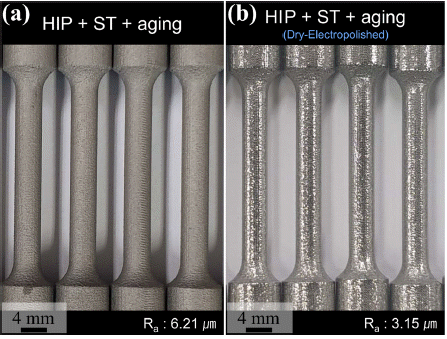Search
- Page Path
- HOME > Search
- [Korean]
- Effect of Stress Relieving Heat Treatment on Tensile and Impact Toughness Properties of AISI 316L Alloy Manufactured by Selective Laser Melting Process
- Dong-Hoon Yang, Gi-Su Ham, Sun-Hong Park, Kee-Ahn Lee
- J Korean Powder Metall Inst. 2021;28(4):301-309. Published online August 1, 2021
- DOI: https://doi.org/10.4150/KPMI.2021.28.4.301

- 724 View
- 4 Download
-
 Abstract
Abstract
 PDF
PDF In this study, an AISI 316 L alloy was manufactured using a selective laser melting (SLM) process. The tensile and impact toughness properties of the SLM AISI 316 L alloy were examined. In addition, stress relieving heat treatment (650°C / 2 h) was performed on the as-built SLM alloy to investigate the effects of heat treatment on the mechanical properties. In the as-built SLM AISI 316 L alloy, cellular dendrite and molten pool structures were observed. Although the molten pool did not disappear following heat treatment, EBSD KAM analytical results confirmed that the fractions of the low- and high-angle boundaries decreased and increased, respectively. As the heat treatment was performed, the yield strength decreased, but the tensile strength and elongation increased only slightly. Impact toughness results revealed that the impact energy increased by 33.5% when heat treatment was applied. The deformation behavior of the SLM AISI 316 L alloy was also examined in relation to the microstructure through analyses of the tensile and impact fracture surfaces.
- [Korean]
- Effect of Dry-Electropolishing on the High Cycle Fatigue Properties of Ti-6Al-4V Alloy Manufactured by Selective Laser Melting
- Dong-Hoon Yang, Young-Kyun Kim, Yujin Hwang, Myoung-Se Kim, Kee-Ahn Lee
- J Korean Powder Metall Inst. 2019;26(6):471-476. Published online December 1, 2019
- DOI: https://doi.org/10.4150/KPMI.2019.26.6.471

- 541 View
- 8 Download
- 5 Citations
-
 Abstract
Abstract
 PDF
PDF Additively manufactured metallic components contain high surface roughness values, which lead to unsatisfactory high cycle fatigue resistance. In this study, high cycle fatigue properties of selective laser melted Ti-6Al-4V alloy are investigated and the effect of dry-electropolishing, which does not cause weight loss, on the fatigue resistance is also examined. To reduce the internal defect in the as-built Ti-6Al-4V, first, hot isostatic pressing (HIP) is conducted. Then, to improve the mechanical properties, solution treatment and aging are also implemented. Selective laser melting (SLM)-built Ti64 shows a primary α and secondary α+β lamellar structure. The sizes of secondary α and β are approximately 2 μm and 100 nm, respectively. On the other hand, surface roughness
R a values of before and after dry-electropolishing are 6.21 μm and 3.15 μm, respectively. This means that dry-electropolishing is effective in decreasing the surface roughness of selective laser melted Ti-6Al-4V alloy. The comparison of high cycle fatigue properties between before and after dry-electropolished samples shows that reduced surface roughness improves the fatigue limit from 150 MPa to 170 MPa. Correlations between surface roughness and high cycle fatigue properties are also discussed based on these findings.-
Citations
Citations to this article as recorded by- High-integrity diffusion bonding of laser powder bed fused, forged, and rolled Ti–6Al–4V alloys
Seoyeon Jeon, Hyunjong Ha, Dong Jun Lee, Hyeonil Park, Yong Nam Kwon, Hyunjoo Choi, Hyokyung Sung
Journal of Materials Research and Technology.2025; 35: 2108. CrossRef - Effect of Building Orientation on Tensile Properties of Hastelloy X alloy Manufactured by Laser Powder Bed Fusion
Seong-June Youn, GooWon Noh, Seok Su Sohn, Young-Sang Na, Young-Kyun Kim
Journal of Powder Materials.2025; 32(2): 130. CrossRef - Surface finishing by shape-adaptive processes
Jiwang Yan, Brigid Mullany, Anthony Beaucamp, Daniel Meyer, Naohiko Sugita
CIRP Annals.2025; 74(2): 1019. CrossRef - High-Throughput Microstructural Characterization and Process Correlation Using Automated Electron Backscatter Diffraction
J. Elliott Fowler, Timothy J. Ruggles, Dale E. Cillessen, Kyle L. Johnson, Luis J. Jauregui, Robert L. Craig, Nathan R. Bianco, Amelia A. Henriksen, Brad L. Boyce
Integrating Materials and Manufacturing Innovation.2024; 13(3): 641. CrossRef - In-situ formed oxide enables extraordinary high-cycle fatigue resistance in additively manufactured CoCrFeMnNi high-entropy alloy
Young-Kyun Kim, Min-Seok Baek, Sangsun Yang, Kee-Ahn Lee
Additive Manufacturing.2021; 38: 101832. CrossRef
- High-integrity diffusion bonding of laser powder bed fused, forged, and rolled Ti–6Al–4V alloys
TOP
 KPMI
KPMI


 First
First Prev
Prev


